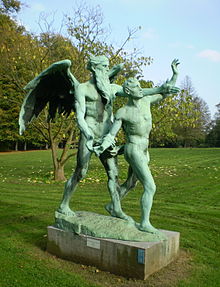User:Yamara/Sandbox2

The motions of Sun and Moon have demonstrated and symbolized time throughout humanity's existence

Time is a dimension of our universe. Objects and events may be identified with positions in time, like space, relative to an observer's frame of reference. Unlike space, movement through time cannot be controlled.
The fundamental importance of time results in great philosophical and spiritual significance. To understand any event, past or present, or to bring any design to a future state of accomplishment requires measurable time, and even the human sense of time varies with time.
Time and its limits are what motivate questions of mortality, life cycles, and the permanence of the universe, and therefore time has always been a fundamental subject of science, religion, philosophy, and art. Its measurement has occupied scientists and technologists, and was a prime motivation in astronomy. Time is also of significant social importance, having economic value as well as personal value, due to an awareness of the limited time in each day and in human lifespans.

The motions of Sun and Moon have demonstrated and symbolized time throughout humanity's existence


Time is a dimension of our universe. Objects and events may be identified with positions in time, like space, relative to an observer's frame of reference. Unlike space, movement through time cannot be controlled. The fundamental importance of time results in great philosophical and spiritual significance. From the dawn of history to the present, questions of mortality, life cycles, and the permanence of the universe have been inextricably linked to the science of chronology. To accomplish absolutely anything requires some measurable time, and even the human sense of time varies with time.
Time has long been a major subject of science, philosophy, and art. Its measurement has occupied scientists and technologists, and was a prime motivation in astronomy. Time is also of significant social importance, having economic value as well as personal value, due to an awareness of the limited time in each day and in human lifespans.
---
There are two distinct views on the meaning of the word time.
One view is that time is part of the fundamental structure of the universe, a dimension in which events occur in sequence, and time itself is something that can be measured. This is the realist's view, to which Sir Isaac Newton subscribed, and hence is sometimes referred to as Newtonian time.[1]
An opposing view is that time is part of the fundamental intellectual structure (together with space and number) within which humans sequence events, quantify the duration of events and the intervals between them, and compare the motions of objects. In this second view, time does not refer to any kind of entity that "flows", that objects "move through", or that is a "container" for events. This view is in the tradition of Gottfried Leibniz[2] and Immanuel Kant,[3][4] in which time, rather than being an objective thing to be measured, is part of the measuring system used by humans.
In physics, time and space are considered fundamental quantities (i.e. they cannot be defined in terms of other quantities because other quantities – such as velocity, force, energy, etc – are already defined in terms of them). Thus the only definition possible is an operational one, in which time is defined by the process of measurement and by the units chosen.
Periodic events and periodic motion have long served as standards for units of time. Examples are the apparent motion of the sun across the sky, the phases of the moon, the swing of a pendulum, heartbeats, etc. Currently, the unit of time interval (the second) is defined as a certain number of hyperfine transitions in Cesium atoms (see below).
Time has long been a major subject of science, philosophy, and art. Its measurement has occupied scientists and technologists, and was a prime motivation in astronomy. Time is also of significant social importance, having economic value as well as personal value, due to an awareness of the limited time in each day and in human lifespans.
- ^ Newton's Views on Space, Time, and Motion - Stanford University http://plato.stanford.edu/entries/newton-stm/
- ^ Leibniz on Space, Time, and Indiscernibles - Against the Absolute Theory -- Internet Encyclopedia of Philosophy http://www.iep.utm.edu/l/leib-met.htm#H7
- ^ Critique of Pure Reason - Lecture notes of G. J. Mattey, UC Davis http://www-philosophy.ucdavis.edu/mattey/kant/TIMELEC.HTM
- ^ Kant's Transcendental Idealism - Internet Encyclopedia of Philosophy http://www.iep.utm.edu/k/kantmeta.htm#H4
